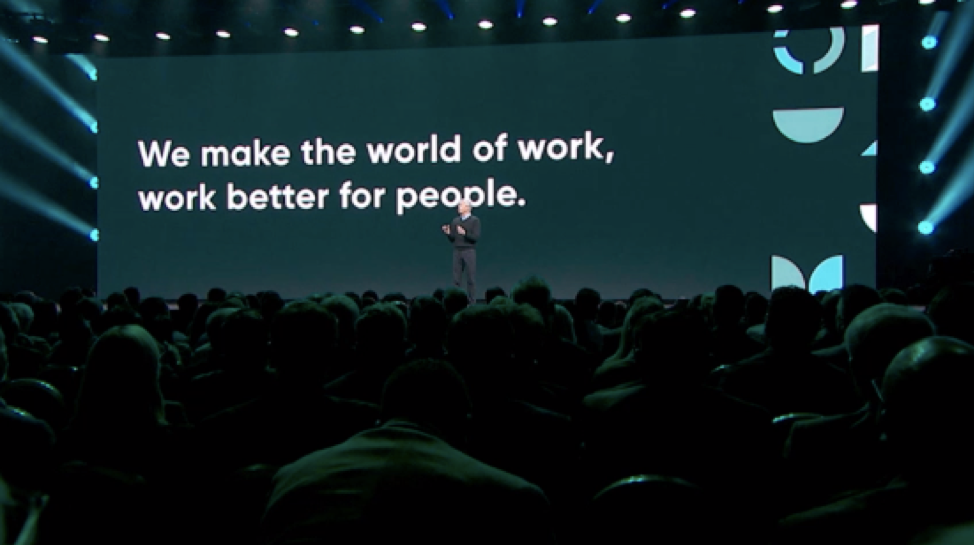By Lisa Chai, Senior Research Analyst, ROBO Global
A new category is emerging for the future of workforce management, and I was happy to witness it first-hand at ServiceNow’s customer conference in New York City last week. At the event, the company drove home the fact that the key to driving a top-notch digital employee experience and unlocking productivity is an advanced employee experience platform—and that this has become a must-have for every HR and IT leader. A clear frontrunner in the space, ServiceNow, a member of the ROBO Global Robotics, Automation & AI Index (ROBO) and the ROBO Global Artificial Intelligence Index (THNQ), is leading the Cloud and AI transformation by adding more ambitious forms of natural language processing that use artificial neural networks to process language and forecast future needs for the digital workforce stack.
ServiceNow’s key message at the conference was that employee experience represents a new paradigm in the enterprise sector—one that many organizations are embracing as a strategic competitive advantage—and that the ServiceNow platform is the key to managing critical IT, employee, and customer workflows to help deliver on that goal.
The challenges facing ServiceNow’s customers are not simple to solve. The proliferation of digital technologies in the workplace has brought intense complexity to the day-to-day employee experience. Recent research by industry analyst and author Josh Bersin indicates that 27% of workers believe they waste one day a week going through useless emails, while more than 40% of employees work over 50 hours a week. This is coupled with the fact that employees take 15% less vacation time than they did 20 years ago. According to the USA Travel Association, Americans left 768 million vacation days unused due to poor time management of the employees themselves—an increase of 9% since 2017. Meanwhile, the number of mobile devices and technology applications that employees are using is increasing every day. New research by Deloitte indicates that companies are using an average of seven different tools for messaging, communication, file sharing, and scheduling. Employees are simply overwhelmed. According to Gartner, 51% of HR directors say employee experience is critical to achieving corporate objectives. Employees want a single platform to help manage their work information, deliver real-time data, and support a frictionless path to the right department and right systems. ServiceNow’s employee experience platform may be the answer.
Enabling the Modern Workforce
ServiceNow recently expanded its vision and product portfolio to support what it calls the truly modern workforce. The company now offers a dozen different applications that support many types of back-office processes using AI algorithms to support each unique workflow. The employee workflow begins on day one on the job, streamlining and simplifying processes like managing payroll, inputting insurance data, and requesting help from IT. From that day on, the solution supports the employee experience by providing a modern, digital workflow that offers functionality using AI and machine learning (ML) capabilities to provide tools like chatbots, virtual agents, and performance analytics—all of which add to the company’s longer-term margins. ServiceNow’s AI product roadmap, mobile experience, platform innovations and agent dashboards are key focus areas as it strives to drive employee engagement, retention, and productivity with rewarding emotional experiences.
According to ServiceNow, HR officers are taking an increasingly strategic approach to organizing cross-functional teams. Dedicated to making employee experience the center of their people strategy, HR leaders know that optimizing the employee experience requires new capabilities and skill sets—and perhaps even shaking up the whole idea of HR as we know it.
The Shift from IT to Workforce Management
ServiceNow’s early solutions focused on automating enterprise IT help desks to facilitate IT incident monitoring and application support. Its recent entrée into the HR and the financial services segments was fueled by one thing: customer need. In my conversations with many ServiceNow customers who are using its HR solutions, it seemed clear that this segment is ripe for growth thanks to the greenfield opportunity it presents and a lack of competition. ServiceNow’s partners expressed excitement around the potential reach of the company’s solutions; among ServiceNow’s customers, the majority of projects require both the core HR solution and the workflow positioning solution in order to handle records management systems requirements. Key customers, including a large European bank and an aviation company, discussed their broader deployments of ServiceNow across their IT, HR, and CSM solutions, and shared how employee experience has become a top priority for them. The customers all echoed the view that using ServiceNow’s platform gives them a better understanding of the major impact digital workforce management has had on their organizations.
An Early-Inning Standout
There’s no question that digital transformation is still in the early innings. At the moment, ServiceNow seems to be making many of the right moves to hold on to its early lead in the space. Based on my conversations with the company’s customers and partners, many are only now putting these digital stacks to work to support their own visions of a truly modern workforce. However, ServiceNow is clearly building on its proven strength in digital workflow solutions to seamlessly integrate the key applications that its customers need to manage employee experience— beginning at the very center of each organization. We see this as a key strength for the company over the longer term, and we anticipate that ServiceNow will continue to expand its offerings through acquisition and internal development using AI as a key enabler of its expanding product roadmap. ServiceNow clearly has an enthusiastic customer base—a fact that will likely support its business model moving forward. As more customers go through renewals of their subscriptions next year, the addition of AI- and ML-based functionalities should be a large driver of top-line growth. Emerging products such as the HR and financial service management solutions should add to that equation to help sustain the 30%+ growth that is expected through next year.





